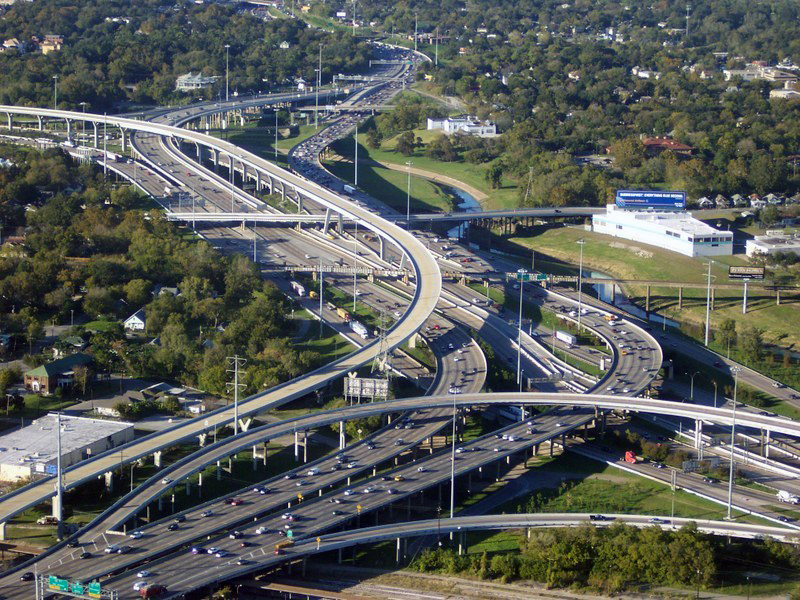For the future of American infrastructure, the August Congressional recess looms large. Since the passage of the Federal-Aid Highway Act of 1956, federal lawmakers have passed 34 short-term extensions for the bill’s funding. The most recent one, passed just before the Memorial Day recess, set a July 31 deadline for deciding how to fund road and infrastructure projects. As the deadline approaches, many are worried: not only is US infrastructure crumbling, but funding for improvements and upkeep is also essential for a wide swath of the American public.
It wasn’t always this dire. In the past, the federal gas tax kept pace with transportation spending and supplied the Highway Trust Fund with cash infusions sufficient to finance the country’s essential bridges, roads, and highways. But the last gas tax hike was in 1993, and the trust fund is now set to run dry by the end of the month.
Republican leaders have made it clear that they’re not in favor of any new gas taxes. Meanwhile, President Obama has hinted that he’s more than fed up with stop-gap measures —meaning he might veto a temporary funding patch, like the one passed by the House before Memorial Day that’s now lingering in the Senate. Adding to the confusion is the fight over the Export-Import Bank, the charter for which Republicans let expire earlier this summer. Democrats and “business-backed Republicans” have targeted the highway funding bill as the perfect place for a rider reauthorizing the Bank, but that strategy has only increased the potential for catastrophic gridlock. There are also discrepancies on how long a temporary highway funding extension should last, adding ever more fuel to the fire.
The only thing everyone can agree on is that something must be done — providing money for transportation infrastructure is a must. But the rhetoric on the Hill surrounding the bill doesn’t match the reality of the legislation’s importance to the entire country.
A smart option — although one that is unlikely to happen before close-of-business in July — would be to fund the Highway Trust Fund as part of a civil defense package, combining it with other defense funding and rebranding it as part of a military category. For years, highway funding has been standalone, bringing along perennial, partisan fights each time it’s considered. Rebranding highways as defense spending would not only make it clearer that transportation funding is not something to mess with — it would also set a precedent of importance, since defense funding rarely faces the level of opposition civilian programs do, helping to ensure that future funding avoids the entanglement we see today. Much in the way that the packaging of food stamps with farm subsidies has largely protected both programs, transportation spending could be grouped with defense funding to keep it out of the hands of lawmakers deigning to use it as a political tool.
Such a proposal may seem out of the blue for those who have been following the transportation debates, but it actually has a historical basis. Like so many modern facets of American life (microwave ovens, antibiotics, GPS, and safety razors), highways have their roots in the military. On the obvious side, there’s the fact that the Highway Act also goes by the name National Interstate and Defense Highways Act. The “defense” moniker comes from the dual realities that the bill’s original funding was diverted from defense projects as well as from the fact that the layout of the highway system was designed to connect to nearly all U.S. Air Force bases. In fact, the roads were partially conceived as emergency runways for airplanes, though imagine the traffic. Since the Act’s establishment, the Department of Defense has continued to be involved in identifying highways that need upgrades.
A key motivation for the Highway Act in the first place was defense against the possibility of large-scale warfare. In 1953, Robert Mitchell, a prominent city planner, advocated for federal highways by telling President Eisenhower that “densely packed urban concentrations [are] so vulnerable to attack that the security of the nation would be severely threatened in another war,” explaining that highways would be crucial for providing wartime evacuation routes and for encouraging the defensive decentralization of American cities. Such arguments, advocated in journals like The Bulletin of Atomic Scientists, were surprisingly influential in the passage of the 1956 Federal Highway Act. Lobbyists from the American Road Builders Association and various construction and automobile companies used these defense-based arguments as they pushed for the bill’s passage. For example, the chairman of Eisenhower’s commission to study highway proposals, Lucius Clay, testified before Congress that the highways were a national defense priority, saying that they would be “roads for survival” and “necessary for defense needs.” Although Clay may have been actively searching for compelling reasons — he also held a position on the board of directors for General Motors — Eisenhower bought the line of logic. On signing the Act, he declared: “[In] case of atomic attack on our key cities, the road net must permit quick evacuation of target areas.”
Today, this reality is rarely ever forefront in our minds. Drivers no longer imagine military aircraft taking flight from the bowels of Route 66, and highways are only recalled as evacuation tools in advance of impending natural disasters. Although to this end they continue to need improvements, as the mass evacuations for Hurricanes Katrina and Rita show. Nevertheless, highways were designed to be — and they remain — an integral part of US civil defense. Their funding, then, should be treated as such.
